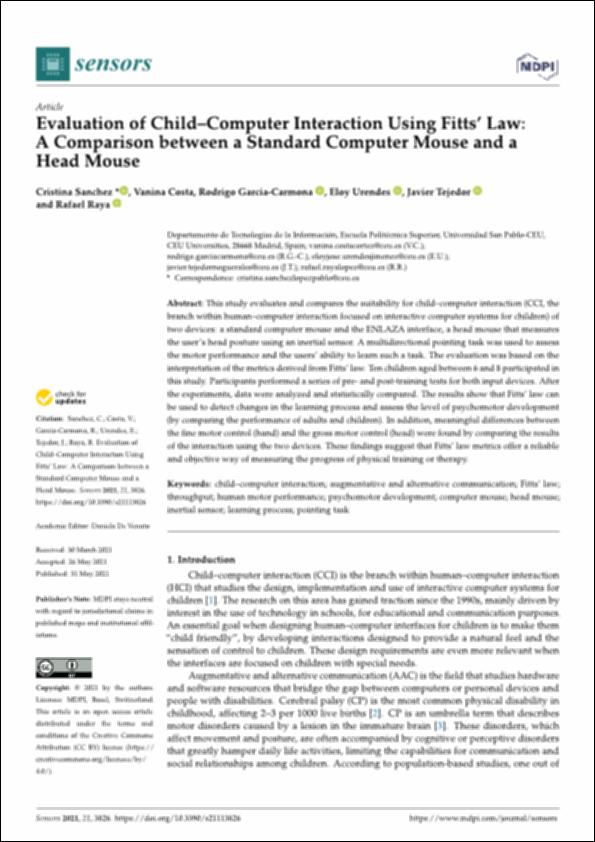Por favor, use este identificador para citar o enlazar este ítem:
http://hdl.handle.net/10637/15099Evaluation of Child–Computer Interaction Using Fitts’ Law: A Comparison between a Standard Computer Mouse and a Head Mouse
| Título : | Evaluation of Child–Computer Interaction Using Fitts’ Law: A Comparison between a Standard Computer Mouse and a Head Mouse |
| Autor : | Sánchez López de Pablo, Cristina Costa Cortez, Vanina Andrea García Carmona, Rodrigo Urendes, Eloy Tejedor Noguerales, Javier Raya López, Rafael |
| Materias: | Child–computer interaction; Augmentative and alternative communication; Fitts’ law; Psychomotor development; Inertial sensor; Learning process; Pointing task |
| Editorial : | MDPI |
| Citación : | Sanchez, C.; Costa, V.; Garcia-Carmona, R.; Urendes, E.; Tejedor, J.; Raya, R. Evaluation of Child–Computer Interaction Using Fitts’ Law: A Comparison between a Standard Computer Mouse and a Head Mouse. Sensors 2021, 21, 3826. https://doi.org/10.3390/s21113826 |
| Resumen : | This study evaluates and compares the suitability for child–computer interaction (CCI, the branch within human–computer interaction focused on interactive computer systems for children) of two devices: a standard computer mouse and the ENLAZA interface, a head mouse that measures the user’s head posture using an inertial sensor. A multidirectional pointing task was used to assess the motor performance and the users’ ability to learn such a task. The evaluation was based on the interpretation of the metrics derived from Fitts’ law. Ten children aged between 6 and 8 participated in this study. Participants performed a series of pre- and post-training tests for both input devices. After the experiments, data were analyzed and statistically compared. The results show that Fitts’ law can be used to detect changes in the learning process and assess the level of psychomotor development (by comparing the performance of adults and children). In addition, meaningful differences between the fine motor control (hand) and the gross motor control (head) were found by comparing the results of the interaction using the two devices. These findings suggest that Fitts’ law metrics offer a reliable and objective way of measuring the progress of physical training or therapy. |
| URI : | http://hdl.handle.net/10637/15099 |
| Derechos: | OpenAccess http://creativecommons.org/licenses/by-nc-nd/4.0/deed.es |
| ISSN : | 1424-8220 |
| Fecha de publicación : | 31-may-2021 |
| Aparece en las colecciones: | Escuela de Politécnica Superior |
Los ítems de DSpace están protegidos por copyright, con todos los derechos reservados, a menos que se indique lo contrario.


